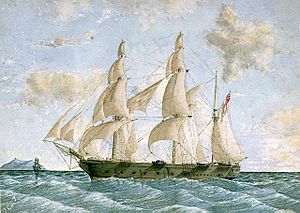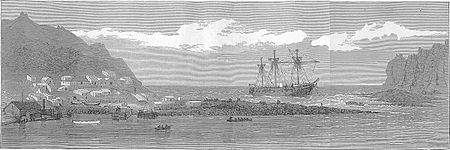HMS Megaera (1849) facts for kids

HMS Megaera in 1869
|
|
Quick facts for kids History |
|
|---|---|
| Name | HMS Megaera |
| Builder | William Fairbairn, Millwall |
| Launched | 22 May 1849 |
| Fate | Wrecked 16 June 1871 |
| General characteristics | |
| Class and type | Frigate |
| Displacement | 2,025 long tons (2,057 t) |
| Length | 207 ft (63 m) |
| Beam | 37 ft 8 in (11.48 m) |
| Draught | 26 ft 3 in (8.00 m) |
| Propulsion |
|
HMS Megaera was a large iron ship built for the Royal Navy in 1849. She was meant to be a powerful warship called a frigate, but things changed before she ever got to fight. Instead, she became a ship that carried supplies and people.
Contents
From Warship to Transport
When Megaera was launched in 1849, she was one of the first iron ships the Royal Navy ordered. She was named after a figure from old Greek stories, Megaera, who was one of the Furies.
However, Megaera never served as a fighting warship. Around the time she was ready, tests showed that the iron used in ships back then could easily splinter if hit by cannonballs. This made ships like her unsafe for battles.
So, the Royal Navy decided to remove the weapons from Megaera and her four sister ships. They were used instead to carry supplies and troops. But these ships weren't very good at their new job. They didn't have enough space for many people, and their engines weren't very strong.
On her very first trip carrying troops in 1851, Megaera broke down and had to be pulled back to port. After repairs, she sailed again, told to use her sails more to save coal. She later carried supplies during the Crimean War. Some of her crew even went ashore to fight. After the war ended in 1856, she continued her regular trips, moving supplies and new personnel for the military.
The Final Journey
In 1871, Megaera was given an important mission: to take new Royal Navy recruits to Australia. These recruits were going to join the crews of other ships, Blanche and Rosario. She left England on February 22, 1871.
During the journey, she was damaged in a storm and had to stop for repairs in Queenstown, Ireland. The ship's officers complained that the ship was carrying too much weight and was sitting too low in the water. This even led to an article in The Times newspaper and questions being asked in the House of Commons. After an inspection, 127 tons of cargo had to be removed.
On May 28, Megaera left Simonstown, South Africa. On board were 42 officers, 180 sailors, and 67 recruits heading to Australia. On June 8, a leak was found in the ship's lower part. For several days, the crew managed the water using hand-pumps.
Around June 14, the leak became much worse, and the hand-pumps couldn't keep up. The steam pumps were then used, and they just barely managed to control the water. On June 15, Captain Thrupp decided to steer for the closest land, the uninhabited Saint Paul Island. He hoped to anchor there and check the ship's hull.
Stranded at Saint Paul Island

On June 17, 1871, the ship anchored at Saint Paul Island so the leak could be examined. A diver was sent down to inspect the damage. However, the anchor cable broke, and they had to pull the diver back up before he could finish. After a second anchor cable snapped, Megaera's divers finally managed to inspect the ship.
They found a big problem: one of the iron plates on the ship was worn away and had a hole. The edges of the hole were so thin they could be bent by hand! Many of the ship's support beams were also rusted through at the bottom, and others were almost completely rusted.
Captain Thrupp later explained that the ship's main supports were coming apart from the bottom. The bottom itself was leaking in one spot and very thin in many others. The pumps kept getting clogged with pieces of iron. The chief engineer of Megaera, George Mills, told Captain Thrupp on June 17 that it would be very unsafe to continue the journey to Australia, which was 1,800 miles away. Two other engineers on board agreed with him.
Because the weather was very stormy and the anchorage wasn't safe, Captain Thrupp told the crew on the morning of Sunday, June 18, that they would land on the island right away. The next day, due to the stormy weather and the difficulty of keeping the ship in place (she had lost three anchors), it was decided to run the ship aground on purpose. Captain Thrupp steered Megaera onto a sandbar at full speed. Her front part was in 10 feet of water, and her back part in 18 feet. At high tide, the ship filled with water up to the main deck.
Over the next week, the crew unloaded the ship's food and supplies. The ship was not completely abandoned for 11 days. By then, two-thirds of the cargo had been taken off.
Help Arrives!
On July 16, Captain Visier of the Dutch ship Aurora saw the flagpole that Megaera's crew had put up. Lieutenant Lewis Jones sailed with the Aurora to Surabaya, Java, arriving on August 2. From there, he sent urgent messages to the British Consul in Batavia and to the Royal Navy Commodore in Hong Kong. They quickly ordered Rinaldo to go rescue the stranded crew.
On August 7, another Dutch ship took five men from Saint Paul Island. On the same day, the captain of a British clipper ship called Mountain Laurel asked to be paid to rescue the crew of Megaera. He claimed he would have to throw his own cargo overboard to make room for so many people. Captain Thrupp refused this offer.
On August 26, Lieutenant Jones arrived on the British merchant steamship Oberon with much-needed supplies. Finally, on August 29, the Dutch ship Malacca arrived and took off the remaining survivors of the shipwreck. She took them to Sydney, Australia. The Rinaldo was blown off course by a storm and couldn't help with the rescue. On the way to Australia, the Malacca met a mail steamer heading home, and Captain Thrupp transferred to it.
What Happened Next?
Captain Thrupp and his crew later faced an official inquiry in November 1871 in Plymouth. A special committee was also set up to investigate the loss of the ship. Captain Thrupp was cleared of any wrongdoing. The inquiry decided that running the ship aground was the right thing to do given the dangerous situation.

